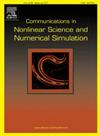The dynamic corridor of regolith transportation near a spinning-up asteroid
IF 3.8
2区 数学
Q1 MATHEMATICS, APPLIED
Communications in Nonlinear Science and Numerical Simulation
Pub Date : 2025-05-07
DOI:10.1016/j.cnsns.2025.108905
引用次数: 0
Abstract
The transport of regolith material has been confirmed by in situ exploration missions to asteroids like Itokawa, Ryugu and Bennu, providing evidences for the topographic evolution of these minor planets. This paper studies the migration of disturbed regolith materials across the asteroid surface from the viewpoint of nonlinear dynamics. We propose a simplified two-dimensional model that captures the dynamics of the regolith migration in a strongly perturbed environment, considering the non-spherical gravitational field induced by a massive body of irregular shape. We choose the shape of the equatorial cross-section of asteroid (101955) Bennu as a representative case. The transport paths of surface particles in terms of the spin-up process are identified. By checking the accessible/forbidden regions in the vicinity of the asteroid, we find that at low spin rates, regolith particles are confined to the vicinity of their initial positions and the motion area is sketched by the boundary of the zero-velocity curve. As the spin rate increases, we observe the formation of a notch that connects the two divided parts of the accessible regions, which creates a C-shaped corridor. Through this corridor, particles can enter cycling orbits around the asteroid, forming a continuous flow of mass movement. The long-term transport tendency of the surface material is found to be governed by this corridor. A higher spin rate enhances the occurrence of large-scale transport of particles across the asteroid surface. Using the methodology developed in this paper, we provide a perspective on the long-term transport dynamics of regolith materials, and it helps us to achieve a macro-analysis of the mass redistribution during the slow spin-up process of an asteroid.
旋转的小行星附近的风化层运输的动态走廊
对Itokawa, Ryugu和Bennu等小行星的原位探测任务证实了风化层物质的运输,为这些小行星的地形演化提供了证据。本文从非线性动力学的角度研究了扰动风化层物质在小行星表面的迁移。我们提出了一个简化的二维模型,该模型考虑了不规则形状的大质量体引起的非球形引力场,可以捕获强扰动环境下的风化层迁移动力学。我们选择小行星(101955)Bennu的赤道截面形状作为代表性案例。根据自旋上升过程,确定了表面粒子的输运路径。通过检查小行星附近的可进入/禁止区域,我们发现在低自旋速率下,风化层粒子被限制在其初始位置附近,运动区域由零速度曲线的边界勾画。随着自旋速率的增加,我们观察到一个缺口的形成,它连接了可进入区域的两个分裂部分,形成了一个c形的走廊。通过这条走廊,粒子可以进入小行星周围的循环轨道,形成连续的质量运动流。地表物质的长期输运趋势受这条走廊的支配。较高的自旋速率增强了粒子在小行星表面大规模传输的发生。利用本文开发的方法,我们提供了一个关于风化层物质长期输运动力学的视角,并有助于我们对小行星缓慢自旋上升过程中的质量再分配进行宏观分析。
本文章由计算机程序翻译,如有差异,请以英文原文为准。
求助全文
约1分钟内获得全文
求助全文
来源期刊

Communications in Nonlinear Science and Numerical Simulation
MATHEMATICS, APPLIED-MATHEMATICS, INTERDISCIPLINARY APPLICATIONS
CiteScore
6.80
自引率
7.70%
发文量
378
审稿时长
78 days
期刊介绍:
The journal publishes original research findings on experimental observation, mathematical modeling, theoretical analysis and numerical simulation, for more accurate description, better prediction or novel application, of nonlinear phenomena in science and engineering. It offers a venue for researchers to make rapid exchange of ideas and techniques in nonlinear science and complexity.
The submission of manuscripts with cross-disciplinary approaches in nonlinear science and complexity is particularly encouraged.
Topics of interest:
Nonlinear differential or delay equations, Lie group analysis and asymptotic methods, Discontinuous systems, Fractals, Fractional calculus and dynamics, Nonlinear effects in quantum mechanics, Nonlinear stochastic processes, Experimental nonlinear science, Time-series and signal analysis, Computational methods and simulations in nonlinear science and engineering, Control of dynamical systems, Synchronization, Lyapunov analysis, High-dimensional chaos and turbulence, Chaos in Hamiltonian systems, Integrable systems and solitons, Collective behavior in many-body systems, Biological physics and networks, Nonlinear mechanical systems, Complex systems and complexity.
No length limitation for contributions is set, but only concisely written manuscripts are published. Brief papers are published on the basis of Rapid Communications. Discussions of previously published papers are welcome.
 求助内容:
求助内容: 应助结果提醒方式:
应助结果提醒方式:


